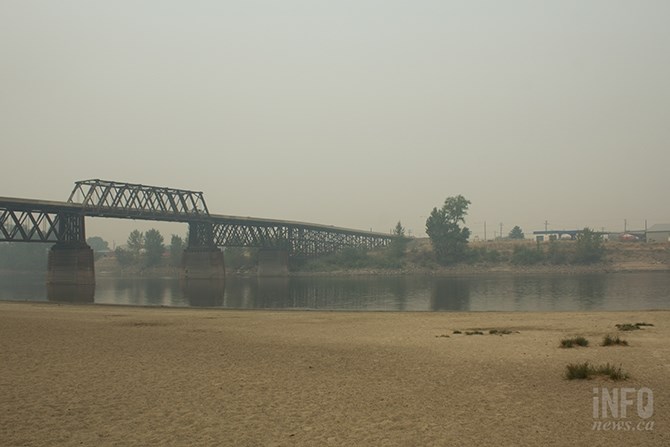
On Aug. 3, Kamloops' air quality health index was ranked at a 49.
(ASHLEY LEGASSIC - REPORTER / iNFOnews.ca)
August 12, 2017 - 4:30 PM
With more than 100 wildfires burning across the province, residents are getting used to – and sick of – the smoke that comes with them.
Nearly everyday for the past month, an air quality health index number is tagged along with the daily weather report for the Southern Interior and other parts of the province. The number has ranged from a five, to a seven, all the way up to a shocking 49 in Kamloops. However, on a scale that appears to range from one to 10, how can that even be possible?
“I realize it’s alarming for people to see a 40 on a scale of one to 10, but that’s not to say it’s completely off the charts, there is a category for it,” provincial air quality meteorologist Donna Haga says. “The scale doesn’t end at 10, we just don’t often see numbers in that higher category.”
The air quality health index is a scale officials use to provide the public with health messages and alerts regarding risks associated with air pollution.
There are four categories in the Environment Canada index. When the health risk is low, the index will rank from one to three. A moderate health risk is four to six and a high risk is seven to 10. Anything above 10 is considered very high.
The three most common air pollutants known to harm health are ozone at ground level, nitrogen dioxide, and particulate matter. The more of these particles present in the air, the higher the risk will be.
Wildfire smoke falls under particulate matter, also known as PM2.5. Haga says the particulate matter caused by the wildfires is driving the air quality health index up.
“We use an algorithm based on the combination of known health risks and current concentrations of pollutants in the air,” says Haga. “I don’t think people need to be concerned with how it’s calculated, but rather what it means.”
Although the at-risk population, like elderly people, infants and anyone with cardiac or respiratory issues should be cautious when spending time outdoors, Haga says there's no reason to panic.
For those that are noticing the smoke is affecting their health, Haga recommends limiting strenuous outdoor activity, staying cool and hydrated, and finding places with air filtration – if not in your home, then a public space.
“In a nut shell, use common sense. If you’re going about your normal activities and feel fine, continue,” Haga says. “If you’re not feeling fine, if you’re having difficulty breathing, chest pain, coughing or irritation in your air ways, then you should curtail your activities.”
To stay up to date on the current air quality in your region click here.
To contact a reporter for this story, email Jenna Hickman or call 250-808-0143 or email the editor. You can also submit photos, videos or news tips to the newsroom and be entered to win a monthly prize draw.
We welcome your comments and opinions on our stories but play nice. We won't censor or delete comments unless they contain off-topic statements or links, unnecessary vulgarity, false facts, spam or obviously fake profiles. If you have any concerns about what you see in comments, email the editor in the link above.
News from © iNFOnews, 2017